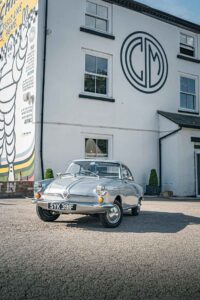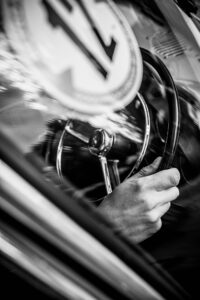Often forgotten amongst the swollen ranks of car manufacturers that came and went during the 20th century, NSU always dared to be different, and Alex’s Sport Prinz is now a left-field air-cooled classic that marries German engineering with Italian design.
Say you want a classic air-cooled car. There are plenty of choices out there. A Beetle, obviously, or one of its many platform-mates. A classic 911, or a 912 if your budget’s tighter. Want to go Italian? Fiat 500. American? Chevy Corvair. French? Citroen 2CV. Air cooling was once so commonplace that there’s a whole slew of relatively attainable, plentiful and easy to maintain classics out there.
But let’s say none of these ‘obvious’ choices float your boat. Dig around a little further, and there are plenty of air-cooled obscurities out there. Perhaps a BMW 700? A Tatra? A Panhard? Honda 1300, anyone?
Or, you could track down an NSU Prinz – a small, rear-engined, air-cooled car that emerged from West Germany during the middle of the 20th century. Just not the one you’re thinking of.
During their existence, NSU were never particularly concerned with doing things normally. They’re one of those car companies that started out completely outside the automotive realm – in fact, they were around before the car as we understand it was, having started out in 1873 as a manufacturer of knitting machines. Wheeled transport gradually appeared as the 19th century became the 20th, first bicycles, then motorbikes and finally, in 1905, cars.
The Great Depression forced NSU to stop building cars in 1929, and the Second World War meant they’d only build two-wheelers until 1958, when the Prinz appeared. The original Prinz was a curious-looking thing – a tiny little three-box saloon design with a tall, cab-forward look that brings to mind a dog sitting on its hind legs to beg. Out at the back was a 583cc inline-two making 20hp (later ‘high-performance’ versions would rock a mighty 30hp).
There’s not a great deal else to say about the standard Prinz, save for its cosmic connection: when a Florida Chevrolet dealer offered a special $1-a-year lease deal on a new Corvette to the ‘Mercury Seven’, the first seven astronauts selected by NASA to crew manned US space flights, six of them jumped at the offer. The one who didn’t was the frugally-minded John Glenn, who chose to keep his existing transport – a fuel-efficient NSU Prinz.
Later Prinz saloons grew in size in both the body and engine departments, and wound up looking like a cross between a Chevrolet Corvair and Hillman Imp, two other rear-engined stalwarts of the day. They’re not really what we’re interested in either, though, because this little silver coupé, looking a little like somebody’s fired a shrink ray at an Aston Martin DB4, is a Sport Prinz.
Based on the bones of the early Prinz, the coupé was also introduced in 1958, and is one of few cars in history to feature the golden combination of German engineering and Italian styling. Its petite body was penned by Franco Scaglione for Bertone. Scaglione, whose best-remembered works are arguably Alfa Romeo’s spectacular BAT concept cars, had a penchant for torpedo-tube headlights and tapering, fin-adorned tails, both of which are transposed in miniature onto the Sport Prinz.
The Sport Prinz began life with the same 583cc inline-twin as the standard car, before a 1962 update brought an upgrade to 598cc, bringing with it a tyre-shredding 36hp. It had a decade-long lifespan, ending production in 1968 with sporty versions of the standard Prinz picking up NSU’s performance baton.
This silver Sport Prinz is owned by C&M regular Alex, who has a real fondness for the unusual. “There are so many things on this car that are really clever that we just don’t have on cars today,” explains Alex. “I really like [NSU] as a company, their ideas were really good… really ahead of their time. Apart from looking good and being a fun car to drive, it’s just really interesting – that’s what I was looking for.”
Alex acquired the car off the back of a time-killing browsing session on a popular classic car classifieds site, something lots of us are all too familiar with. It’s less common that these sessions materialise into actually having a new car on the drive, but that’s exactly what happened for Alex, who described the ad as having “the hallmarks of a ‘this isn’t going to be sold for a while’ advert. The pictures were low quality, the description wasn’t very long, it just said ‘give us a call and come and look at the car, so I did.”
Alex has a couple of other cars in his stable, although neither are exactly what you’d describe as a sensible daily. The closest is a Peugeot 205, and there’s also a 1275cc MG Midget, a Facebook Marketplace acquisition that he describes as “very leggy.” While the Peugeot is the car he actually refers to as his daily, the Prinz has been getting some proper use over the summer of 2023. “I’ve done long trips in it, just used it for daily driving… it’s actually quite relaxing to be in, it’s just not as sporty as other stuff that’s out there of that era.
“It’s not ‘fun’ in the typical way… it’s more refined than that. It was kind of the ‘family’ sports car, it wasn’t that raw. The engineering behind it was really good, but it’s not that seat of your pants. Being [rear-engined]… anyone who’s driven [something like] a Hillman Imp will know how light the steering is – there’s no weight at the front, you’ve not got that much feedback, the tyres are skinny… there’s not that much feel.”
It’s worth noting Alex’s age – he’s 18. Drop into the Yard at The Hill or The Bowl on any given day and you’ll quickly discover that the oft-repeated notion that millennials and Gen Z-ers aren’t interested in cars is nonsense. Even with that in mind, though, Alex’s taste is notably eclectic.
“I come from a car family… my grandad went through Jaguars, Triumphs, then Citroens… it was always something a bit different. And my dad had a 205 and an E30 BMW [when I was growing up]. I just like the quirky stuff. As nice as it is to have a car that lots of other people have, it’s also nice to have a car that no-one else knows and have those questions come up. It’s more than the cars, it’s their place in history… looking through old brochures, receipts, service history – you can live back in time.”
Time is an appropriate note to end on, because it’s something that NSU were always ahead of – to their ultimate loss. In 1964, a convertible version of the Sport Prinz appeared, simply called the NSU Spider. Typical of the habitually weird company, it wasn’t simply a Sport Prinz with the roof lopped off – instead of using the same inline-twin, it was the first production car ever with a Wankel rotary engine, beating Mazda to the punch by around a year.
NSU were the only other manufacturer to give rotary tech a proper shot at mass production, and it would be their undoing. 1967’s Ro 80 saloon was astonishingly forward-facing, with a twin-rotor Wankel engine, an innovative clutchless manual transmission, four-wheel disc brakes and fully-independent suspension; all features largely unheard of in mainstream cars of the time.
The Ro 80 was immediately flooded with acclaim and awards, but the rotary engines quickly proved frightfully troublesome. NSU were replacing entire engines under warranty that had only covered 15,000 miles, and combined with the Ro 80’s thirst for fuel against the backdrop of 1973’s oil crisis, the car pretty much drove the company into bankruptcy.
NSU was taken over by Volkswagen in 1969, and the NSU name was dropped altogether in 1977. That wasn’t quite the end of the story, though – the name NSU was an abbreviation of Neckarsulm, the small German city where it was based for most of its life. When VW acquired the company, it began to shift production of another brand it had recently acquired to Neckarsulm, a revival of another small German manufacturer whose name had been dormant since before World War II. Its name was Audi – wonder what happened to them?
The sprawling plant at Neckarsulm has been producing cars ever since, including the game-changing R8 and electric e-tron GT. In other words, Audi’s howling V10 supercar owes at least a little of its existence to this largely-forgotten twin-cylinder curiosity from the middle of the 20th century – the artist formerly known as the NSU Prinz.




















